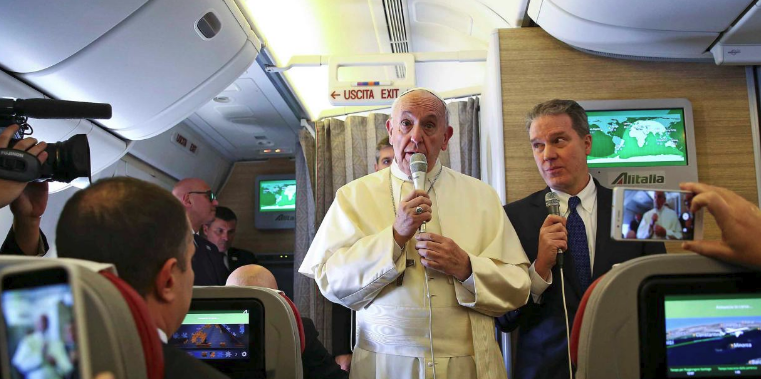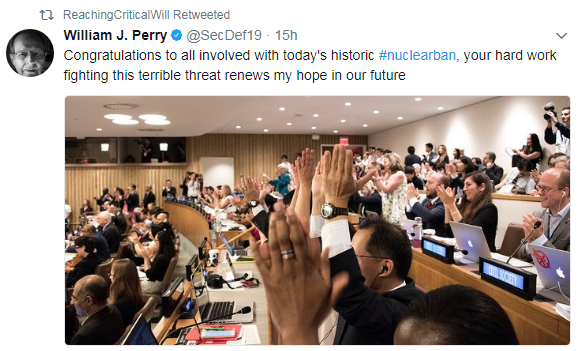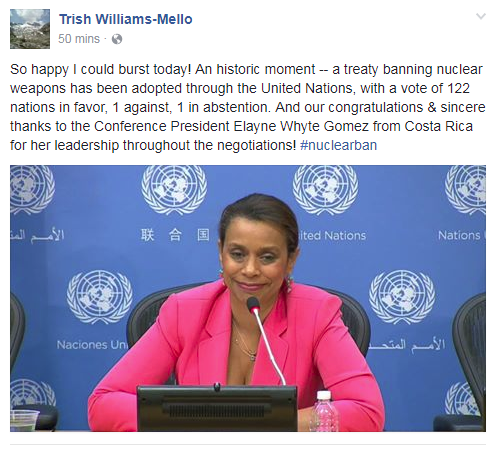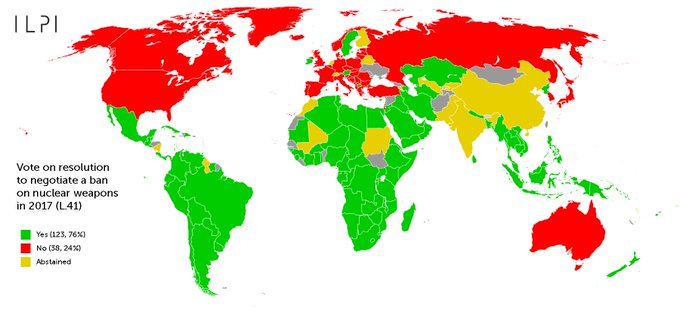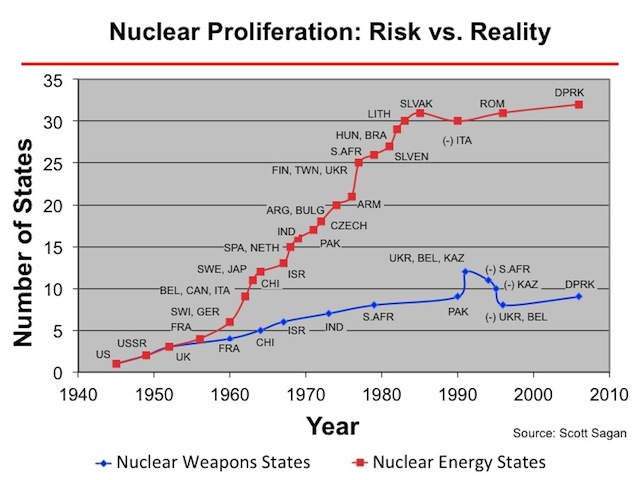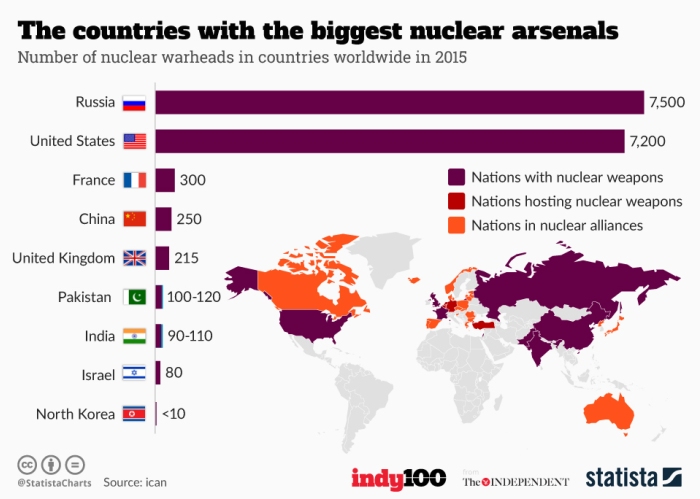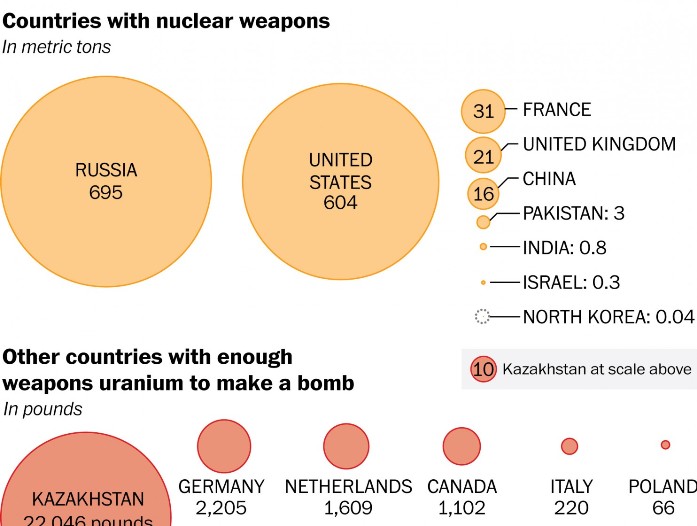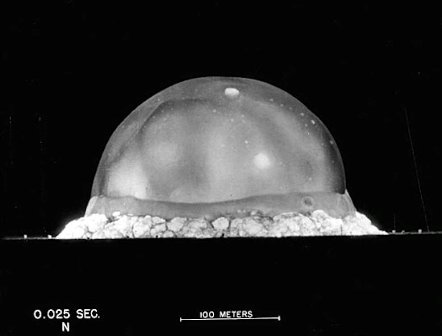Nuclear Nonproliferation: Difference between revisions
Siterunner (talk | contribs) No edit summary |
Siterunner (talk | contribs) No edit summary |
||
| Line 16: | Line 16: | ||
<font color=green> | <font color=green>○ ○ ○ ○ ○ ○ ○</font> | ||
| Line 27: | Line 27: | ||
<font color=green> | <font color=green>○ ○ ○ ○ ○ ○ ○ ○</font> | ||
Revision as of 14:49, 25 September 2018
The New START Treaty will expire in 2021. If it does, Russia and the Unites States could bust through the ceiling the accord places on each side’s long-range nuclear forces — the missiles and bombers that can span oceans to deliver nuclear bombs in as little as 30 minutes after launch.
For the first time since President Richard Nixon negotiated the SALT Treaty in 1972, there would be no limit to the number or types of strategic weapons Russia and the United States deploy.
Worse, Russia and the United States would lose all inspections, tracking and verification of these arsenals, which account for over 92 percent of all the nuclear weapons in the world. This would introduce major uncertainties into a relationship already strained with mistrust and suspicion.
U.S. Ambassador to Russia Jon Huntsman says arms control “will be prominent on the agenda,” and that the two sides “will have to make a decision on whether or not there [will] be a re-upping for five years.” Huntsman notes, “We have passed a very important milestone last Feb. 5 where both the United States and Russia were to meet the internal goals of no more than 1,550 deployed strategic warheads. And both met that target, and both have done the accounting to meet that...”
○ ○ ○ ○ ○ ○ ○
January 2018
Pope warns world is one step away from nuclear war
○ ○ ○ ○ ○ ○ ○ ○
November 2017
Pope, in change from predecessors, condemns nuclear arsenals for deterrence
VATICAN CITY (Reuters) - Pope Francis appeared to harden the Catholic Church’s teaching against nuclear weapons on November 10th, saying countries should not stockpile them even for the purpose of deterrence.
His remarks, at the start of a disarmament conference that brought 11 Nobel Peace Prize winners to the Vatican, appeared to go further than previous popes. They have said that while nuclear weapons should never be used, holding arsenals solely to deter other countries from using them could be morally acceptable as a step toward achieving a nuclear-free world.
Addressing the group in the 16th century frescoed Clementine Hall of the Vatican’s Apostolic Palace, Francis spoke of “the catastrophic humanitarian and environmental effects of any employment of nuclear devices”.
He added: “If we also take into account the risk of an accidental detonation as a result of error of any kind, the threat of their use, as well as their very possession, is to be firmly condemned.”
September 2017
Ban the Bomb, Nobel Prize / October 6
- Is the Nobel Committee Finally Abiding by Nobel’s Will?
- Nobel Peace Prize goes to the International Campaign to Abolish Nuclear Weapons -- http://www.bbc.com/news/world-41528743
- Is the Nobel Committee Finally Abiding by Nobel’s Will?
August 2017
Visiting GreenPolicy's Associate, StratDem / August 10
- As nuclear war talk heats up http://www.politifact.com/truth-o-meter/article/2017/aug/10/nuclear-strike-against-north-korea-constitutional-/
- http://strategicdemands.com/stewards-of-the-apocalypse/
Back to the Nuclear Brink / August 9
- #HairTrigger http://strategicdemands.com/?s=nuclear+hair+trigger
On 'First Use' and on Banning Nukes / August 7
July
Treaty Banning Nuclear Weapons Adopted
Banned: Treaty Prohibiting Nuclear Weapons Adopted
Special Issue of the Bulletin of Atomic Scientists
Draft Treaty Prohibiting Nuclear Weapons
At the UN: Abolish Nuclear Weapons / June 16
○ ○ ○ ○ ○ ○ ○ ○ ○ ○ ○ ○ ○ ○ ○ ○ ○
Status of the Nuclear Weapons Ban Negotiations
○ ○ ○ ○ ○ ○ ○ ○ ○ ○ ○ ○ ○ ○ ○ ○ ○
For many years the editor of Strategic Demands has continued an association with the Los Alamos Study Group.
- The LASG team of scientists and public/civil representatives continues to address critical issues involving US nuclear weapons development.
- Currently at the United Nations, the LASG reports on the historic "Convention to Prohibit Nuclear Weapons":
Nations Gather in Unprecedented Meeting to Ban Nuclear Weapons
- ○ ○ ○ ○ ○ ○ ○ ○ ○ ○ ○ ○ ○ ○ ○ ○ ○
Negotiating a global nuclear ban treaty: Nuclear-armed states vs the UN
Expertise and Oversight: Addressing the Need for New Security Approaches
Reviewing the Work of Tom Nichols
Strategies built for the Cold War have survived into the twenty-first century... (In his book, No Use: Nuclear Weapons and U.S. National Security ) Nichols illustrates how America's nearly unshakable belief in the utility of nuclear arms has hindered U.S. and international attempts to slow the nuclear programs of volatile regimes in North Korea and Iran. From a solid historical foundation, Nichols makes the compelling argument that to end the danger of worldwide nuclear holocaust, the United States must take the lead in abandoning unrealistic threats of nuclear force and then create a new and more stable approach to deterrence for the twenty-first century.
Ⅰ Ⅱ Ⅲ Ⅳ Ⅴ Ⅵ Ⅶ Ⅷ Ⅸ Ⅹ
December 2016
“Most significant nuclear disarmament development since Cold War”
Ⅰ Ⅱ Ⅲ Ⅳ Ⅴ Ⅵ Ⅶ Ⅷ Ⅸ Ⅹ
October 27, 2016
The United Nations today adopted a landmark resolution to launch negotiations in 2017 on a treaty outlawing nuclear weapons. This historic decision heralds an end to two decades of paralysis in multilateral nuclear disarmament efforts.
At a meeting of the First Committee of the UN General Assembly, which deals with disarmament and international security matters, 123 nations voted in favour of the resolution, with 38 against and 16 abstaining.
The resolution will set up a UN conference beginning in March next year, open to all member states, to negotiate a “legally binding instrument to prohibit nuclear weapons, leading towards their total elimination”. The negotiations will continue in June and July.
The ‘No’ votes came from the nuclear weapons states, and U.S. allies in NATO, plus Japan, South Korea and Australia, which have treaty ties to the U.S., and consider themselves to be under the protection of the ‘U.S. nuclear umbrella.’
Four nuclear weapons states broke ranks, with China, India and Pakistan abstaining, and North Korea voting in favor of the treaty negotiations. In addition, the Netherlands defied intense pressure from the rest of NATO and abstained, as did Finland, which is not a member of NATO but has close ties with the alliance.
The German Press Agency reported: "Due to U.S. pressure, 27 of the 28 NATO member states voted against the resolution with the Netherlands abstaining."
As a follow-on to last week's review of a "Bad Week for the Global Anti-Nuke Movement" and the increasingly vocal doctrine of the Catholic Church that Pope Francis presented last September to the UN -- an 'abolition' position and advocacy of an effective ban on nuclear weapons -- this week we look to the upcoming unprecedented vote at the UN to ban/outlaw nuclear weapons...
Years ago, your GreenPolicy siterunner worked as a consultant to assist the Los Alamos Study Group. Working relationships I had developed in Washington DC over the years, especially with Congressman George E. Brown and Senator Paul Wellstone, became key go-to channels. My close political relationship with Congressman Brown began in the mid 1960s, when he first began 'mentoring' me on nuclear issues after convincing me to enter a political life as a young man who was debating nuclear proliferation -- often against Jesuit-educated students.
Today, a Jesuit pope, the first Jesuit educated pontiff, has adopted the name of Francis in honor of the saint of the environment and has quickly brought the Catholic Church to a new position on larger, existential issues globally, including environment, health and security. The Church and its over 1 billion+ followers are now looking at new ways to see the world -- and the vision of a nuclear-free world is up for consideration.
I look back to the 1990s, twenty+ years after I first met George Brown and a few years after meeting and talking with Pope John Paul. I was then living in Santa Fe, a city named after St. Francis and I first began to advise the Los Alamos Study Group. I arranged meetings with George Brown to discuss 'big science' issues and nuclear drawdown issues that the Congressman supported in his roles over the years, including as chair of the House Science Committee. George Brown was a visionary leader and the nation lost a patriot when he passed away in 1999.
The Los Alamos Study Group's director, Greg Mello, continues to bring unique perspective on the national labs in New Mexico where the nuclear weapons were first created and, as often is said, a 'nuclear priesthood' maintains the weapon system designs and capabilities. The new trillion dollar "modernization" of the US nuclear weapon complex, systems and capabilities is, to a significant extent, going to be offered up by these physicists and engineers of the nuclear age.
At the same time, the nuclear age is changing from a US dominated nuclear world to a multi-polar world, even as the 'communist threat' ended with the collapse of the Soviet Union over 20 years ago.
Today nuclear weapons are again being improved, made smarter and more 'usable' with guidance systems and 'dial-up yields'. New delivery systems that cruise with the object of avoiding defense systems are far along in development and are soon to be deployed with next generation F-35s fighters, even as the nuclear triads of the US, Russia and China -- and delivery systems of other nuclear weapon holding countries are reconfiguring and developing new capabilites and counter defense and offensive systems.
The response of non-nuclear weapon countries has changed as this new nuclear era commences and, for the first time, there is to move to ban nuclear weapons outright. This coming week or soon thereafter there will be a vote at the UN General Assembly.
The goal -- “to cooperate with all relevant stakeholders … to stigmatise, prohibit and eliminate nuclear weapons in light of their unacceptable humanitarian consequences and associated risks”; and to “fill the legal gap for the prohibition and elimination of nuclear weapons”.
Read More:
http://strategicdemands.com/to-ban-or-not-to-ban/
Greg Mello of the Los Alamos Study Group reports on this history-making event:
Resources re: the BAN movement, via LASG
Resolution L41, “Taking forward multilateral nuclear disarmament negotiations,” with 48 co-sponsors as of two days ago, is coming to vote sometime between this Thursday, 27 October, and the following Wednesday, 2 November. Citizen diplomats from around the world affiliated with ICAN who are gathered at the UN in New York), believe the most likely date and time for this vote is this Thursday, between 3:00 and 6:00 pm Eastern time.
It is a moment of high drama in disarmament affairs. For the UN to mandate negotiations to ban nuclear weapons – a process now happening, led by non-nuclear states – is unprecedented. It is the most significant development in nuclear disarmament since the end of the Cold War.
This resolution is all but certain to pass. Some 127 countries have pledged to support ban negotiations (or 139, counting the countries which voted for the same pledge in the form of an UNGA resolution last fall), about two-thirds of the 193 UN member states.
This negotiating mandate is a product of the rising multipolar world, as U.S. diplomats recognize to their horror and outrage. Much more than the legitimacy and status of nuclear weapons is in play. As we wrote last year, “…the ban process is not just about nuclear weapons. It’s also about power and initiative in world affairs – who has it, and who does not. The ban process, as opposed to other [purely] hypothetical disarmament paths (steps, building blocks, comprehensive binding disarmament treaties, and all other processes which nuclear weapon states can veto) is about who decides whether nuclear weapons are legitimate.
The Washington Post called the ban process an “uprising among civil society groups and the coalition of 107 [now 127] states, which are seeking to reframe the disarmament debate as an urgent matter of safety, morality and humanitarian law.”
A ban treaty would stigmatize and prohibit nuclear weapons, closing the “legal gap” stemming from nuclear weapon state practice and their associated assertion in diplomatic and legal fora that nuclear weapons are completely legitimate weapons – for them, and them only.
It has always been a stated UN goal to eliminate nuclear weapons, going back to the very first resolution of the UNGA in 1946.
The political commitments being made in this process are already freshly stigmatizing nuclear weapons. They are bringing into diplomatic consciousness and state policy humanity’s inherent revulsion toward these most heinous weapons of mass destruction. In this process the prestige of nuclear weapons, their paralyzing mystique and their practical power in international relations, are already declining.
As of 21 October the 48 co-sponsors of L41 were:
- Angola, Austria, Bahamas, Belize, Brazil, Burundi, Chile, Costa Rica, Democratic Republic of the Congo, Dominican Republic, Ecuador, El Salvador, Fiji, Guatemala, Guinea-Bissau, Honduras, Indonesia, Ireland, Jamaica, Kenya, Liberia, Libya, Liechtenstein, Malaysia, Malawi, Malta, Mexico, Namibia, Nauru, New Zealand, Nigeria, Palau, Panama, Papua New Guinea, Paraguay, Peru, Philippines, Samoa, San Marino, Sierra Leone, South Africa, Sri Lanka, Swaziland, Thailand, Trinidad and Tobago, Uruguay, Venezuela, Zambia.
The resolution’s operative paragraphs mandate “a United Nations conference to negotiate a legally binding instrument to prohibit nuclear weapons, leading towards their total elimination,” to occur “from 27 to 31 March and from 15 June to 7 July 2017, with the participation and contribution of international organizations and civil society representatives.”
Crucially, treaty negotiations would occur under General Assembly rules – that is, without a consensus requirement or veto option for a privileged few, “unless otherwise agreed by the conference.” Creating a negotiating forum without a de facto veto rule has been a major goal of the resolution’s sponsors and this is therefore unlikely to change.
L41 requires the conference to “submit a report on its progress to the General Assembly at its seventy-second session [autumn 2017], which will assess the progress made in the negotiations and decide the way forward” – by majority rule, again.
“The resolution,” as ICAN notes, “acts on a recommendation made in August by a UN open-ended working group on nuclear disarmament in Geneva. More than 100 nations participated in the working group, with an overwhelming majority expressing their support for the prohibition of nuclear weapons as a first step towards elimination.”
The basic case for a nuclear ban treaty can be found here, with links to further information.
Many may find the recent UN press conference on 14 October discussing the ban with Beatrice Fihn, ICAN’s Executive Director, and Professor Matthew Bolton from Pace University, to be both interesting and accessible.
ICAN staff have been live-blogging highlights from the debate. Reaching Critical Will (RCW) has captured and posted many countries’ statements.
Needless to say, the U.S. strenuously opposes any ban treaty and indeed the whole process, which it has vowed to boycott. On Friday Foreign Policy ran a good article by Colum Lynch (“U.S. Seeks to Scupper Proposed Ban on Nuclear Arms”) on U.S. opposition, with this rather sad lede: “Almost eight years after President Barack Obama pledged in a landmark speech in Prague to seek “a world without nuclear weapons,” U.S. diplomats are mounting an aggressive campaign to head off a bid by non-nuclear states to ban such atomic arms.” One of Lynch’s anonymous informants spoke of threats: “Washington has warned states considering voting in favor of the resolution that a ban could jeopardize defense arrangements with allies around the globe.” The hostility and aura of threat in the statements of the U.S. and the U.K. in particular were hard to mistake.
What Lynch did not say was what Assistant Sec of State Thomas Countryman told me (Mello) in August: the U.S. fears the democratic “pressure” a ban will place on our allies, especially in Europe, to rid themselves of nuclear weapons, both physically and in terms of nuclear “umbrella” agreements, while little or no such “pressure” will appear in Russia or China.
············································································
- Nuclear Weapons -- Proliferation v Nonproliferation
Re: the President’s Last Days as Commander-in-Chief
A key focus of GrnPolicy and Strategic Demands 'environmental security, national security' agenda -- nonproliferation, arms control, peace...
StratDem update / July 10, 2016. A month ago we wrote that the president's final day in office should include exec orders addressing nuclear proliferation issues. It looks like we are getting our wish.
http://strategicdemands.com/re-presidents-last-days-commander-chief/
◊
A New Nuclear Arsenal and Reflections on a President’s Last Days in Office
June 19, 2016
http://strategicdemands.com/new-nuclear-arsenal/
Ⅰ Ⅱ Ⅲ Ⅳ Ⅴ Ⅵ Ⅶ Ⅷ Ⅸ Ⅹ Ⅰ Ⅱ Ⅲ Ⅳ Ⅴ Ⅵ Ⅶ Ⅷ Ⅸ Ⅹ Ⅰ Ⅱ Ⅲ Ⅳ Ⅴ Ⅵ Ⅶ Ⅷ Ⅸ Ⅹ
Review of Conference on the Nonproliferation of Nuclear Arms Treaty
April 2015
Nonproliferation or Proliferation? Report from StrategicDemands.com
- The nuclear threat environment is recharging to produce a new era. A multiple nation realignment and force modernization are producing elements of a new Cold War. Entangling alliances are developing. Next-generation nuclear weapons — ‘smarter’, more deliverable, and usable — are in development
The United Nations headquarters in New York is hosting the ninth five-year Review Conference (RevCon) of the Parties to the Treaty on the Nonproliferation of Nuclear Arms (NPT).
The occasion demands a strategic review of the current state of nuclear weapons, the status of nuclear agreements, the future of nuclear weapons development and deployment. The risks of catastrophic nuclear war, the use of nuclear weapons in a strategic or tactical exchange, remain all-too-real. The de-escalation of Cold War US-Soviet Mutually Assured Destruction (MAD) policies, and accompanying series of nuclear weapons disarmament, control and monitoring agreements, is giving way to re-escalation.
A new era of ‘smart’ nuclear weapons and nuclear weapons modernization policies are carried-forward within a framework of “instant alert”, “fire on-warning” policies of the Cold War. The mix of billions in planned new nuclear spending and development will deliver a new and potentially more deadly nuclear order.
The entry of China as a major nuclear weapon player developing its own ‘triad’ of nuclear delivery systems, the mutual defense relations being pursued between nuclear weapon nations, the race to modernize and react to other nations nuclear modernization including Russia, China, India and Pakistan. The latest nuclear arsenal questions regarding North Korea bring warnings of an “arsenal” and Israel and Iran tensions in the Mideast continue as diplomatic negotiations are railed against by US political opponents. All this must give pause to any rationale discourse of security being a function of nuclear weapons modernization and proliferation.
The paucity of discussion/debate and even awareness of what is being funded, what is in the pipeline of many countries is another warning of a nuclear threat environment that is re-casting Cold War risks of flash point, mistakes, provocations, and nuclear exchange.
Let’s look at the RevCon meeting over the next month, beginning with an initial survey of several revealing pieces from the few sources who are tracking the increased nuclear threat.
-=-=-=-=-=-=-=-=-=-=-=-=-=-=-=-=-=-=-=-=-=-=-=-=-=-=-=-=-=-=-=-=-=-=-=-=-=-=-=-=-
- The Nonproliferation Barrier, No Consensus Possible
http://fpif.org/nuclear-non-proliferation-treaty-review-conference-cant-win-for-losing/
The Treaty on the Non-proliferation of Nuclear Weapons (more commonly known as the Nuclear Non-Proliferation Treaty) has long been considered, along with the concept of deterrence, as the strongest bulwark we have against nuclear war. Briefly, the states that had developed nuclear weapons prior to the treaty were allowed to keep them as long as they promised (without being bound to a deadline) to work toward disarmament. Meanwhile, states without nuclear weapons were to refrain from developing them, but would be entitled to nuclear energy.
Like deterrence, the NPT’s reputation is over-rated. That said, at the UN headquarters in New York City from April 27 through May 22, the NPT Review Conference (RevCon) is being held for the ninth time since the treaty entered into force in 1975. This Review Conference marks the end of a five-year review cycle.
In a Los Alamos Study Group bulletin, Executive Director Greg Mello underscores the fundamental problem with RevCon. Any final document with commitments undertaken by the NPT Parties at this RevCon requires consensus of the Parties. This … means that the RevCon … like all eight preceding meetings over the past 40 years, will produce no binding disarmament measures.
With regards to that consensus, Mello quotes Dominique Lalanne for the Armes nucléaires STOP and the French International Physicians for the Prevention of Nuclear War. At the end of each Review Conference a document is submitted for “consensus” approval... The opposition of a single State prevents a consensus and blocks adoption of the final document.
-=-=-=-=-=-=-=-=-=-=-=-=-=-=-=-=-=-=-=-=-
- Nuclear Weapon Systems 'Modernization', a New Arms Race
http://www.washingtonpost.com/world/national-security/how-many-ways-does-the-air-force-need-to-deliver-a-nuclear-weapon/2015/04/20/c33eeb96-e5dc-11e4-81ea-0649268f729e_story.html Via the Washington Post] / by Walter Pincus
At a time of tight defense budgets, why does the Air Force plan to spend billions of extra dollars so that a president 10 or more years from now can have two options if he or she wants to use bombers to attack an enemy with nuclear weapons?
... Think about that. That future president would have the option to employ the planned, manned or perhaps unmanned long-range strike bomber (LRSB) to drop B61-12 nuclear bombs, both of which are now in development.
The proposed cost of 80 to 100 new LRSBs, at about $550 million each, could exceed $55 billion, although not all of it would be for the nuclear mission. The cost of development and production of a new B61 bomb is estimated at $10 billion, although some money would be allocated to fighter bombers attached to NATO…
Arms control treaties between Moscow and Washington brought those numbers down. But the move by both countries to modernize their nuclear-capable long-range cruise missiles and bombers actually lets them take advantage of a loophole in the 2010 New Strategic Arms Reduction Treaty…
On April 5, 2009, in Prague, President Obama set a goal of “a world without nuclear weapons” and got great applause. But then Obama added, “I’m not naive. This goal will not be reached quickly — perhaps not in my lifetime.”
The Senate ratified the new arms treaty on Dec. 22, 2010, but to get Republican votes for the two-thirds majority needed, Obama had to promise to modernize the American nuclear weapons complex and the nuclear delivery systems.
The treaty may have been a step forward to Obama’s goal of a weapons-free world, but the price he paid has turned out to be two steps backward.
-=-=-=-=-=-=-=-=-=-=-=-=-=-=-=-=-=-=-=-=-
- The Costs and Risks of Nuclear Weapon Systems Modernization
“The worldwide modernization craze scrambles the calculus of nuclear disarmament and nonproliferation efforts, challenging the aging underpinnings of the NPT itself,” writes John Mecklin for Foreign Policy. “Unless the United States, Russia, and other powers find a way to agree on reining in their modernization programs, the world’s non-nuclear countries will have increasingly legitimate reasons to ask how they benefit from being part of the NPT — and why they shouldn’t go their own way.”
Via Foreign Policy / by John Mecklin
DISARM (?) AND MODERNIZE
Massive weapons upgrades now underway challenge the entire disarmament regime
“In terms of warhead numbers, the nuclear arms race may be over. But massive weapons upgrades now underway challenge the entire disarmament regime.”
The early decades of the Cold War, NATO made arrangements to bury what were known as atomic demolition munitions (in essence, nuclear mines) at key points in West Germany, to be detonated if Warsaw Pact forces ever invaded. Although this plan, if enacted, might have slowed the enemy advance, it also almost certainly would have turned vast West German territories into radioactive wastelands littered with corpses and smoldering buildings—the stuff of hellish alternative- history scenarios. The West viewed such tactical nukes—NATO fielded 7,000 to 8,000 of these shorter- range, smaller-yield weapons for most of the Cold War—as tripwires in anticipation of the Soviet Union’s own Strangelovian plans for its thousands of tactical weapons. That is to say, the forward positioning of these nukes was a signal: If the Soviet Union invaded Europe, confrontation would escalate quickly to the nuclear realm, and the United States would intervene.
With the end of the Cold War and the reduced risk of a Russian invasion, NATO eliminated almost all its tactical nuclear weapons in Europe. Today, five NATO countries—Belgium, the Netherlands, Germany, Italy, and Turkey—are widely believed to host roughly 200 U.S.-owned nuclear bombs at their air bases. These weapons, variants of the B61 warhead, a stalwart of the American thermonuclear arsenal since the late 1960s, are viewed by some security experts as provocative anachronisms. The critics argue that strategic missiles and bombers posted in the United States and the United Kingdom, along with missiles on nuclear submarines, provide more than enough deterrence against any Russian aggression.
But in the wake of Russia’s annexation of Crimea and the destabilization of Ukraine, the controversy about B61s is being heightened and compounded. In addition to retaining tactical nukes in Europe, the United States plans to modernize the weapons, as well as its arsenal back home, in a remarkably expensive way. This decision has inflamed debate about the depth of the U.S. commitment to the Nuclear Non- Proliferation Treaty (NPT), which allows the United States, Russia, China, the United Kingdom, and France to have nuclear weapons if they promise to eventually disarm.
Today, weapons innovation threatens to become the new mode for arms competition. Washington’s upgrading of the B61-4 bomb, for example, would equip the device with a tail assembly, making it into a precision-guided standoff weapon. An irony is attached to this redesigned device, called the B61-12: It would be able to attack the same targets as previous gravity bombs in the U.S. arsenal, but would do so more accurately and efficiently, using smaller yields that would create less collateral damage and less radioactive fallout. This means the bombs might be seen as more conceivably usable in a limited or tactical conflict. And this is precisely why the U.S. Congress rejected the Air Force’s requests for low-yield, precision-guided nuclear weapons in the 1990s: Their very accuracy increases the temptation to use them.
Nonetheless, under current plans, approximately 480 B61-12s are set to be produced by the mid-2020s, and they would serve all U.S. gravity-bomb missions contemplated for five different aircraft. In addition to deployment in Europe, the U.S. Air Force also intends to use the B61-12 to arm heavy B-2 and B-52 bombers based in America. Even by the standards of defense budgets, the B61 modernization program is exorbitant: Estimates place its ultimate cost north of $10 billion, or more than if the bombs were constructed of solid gold.
But the high cost and questionable utility of the B61 program are not anomalies—nor is the fact that the plan has received little publicity.
-=-=-=-=-=-=-=-=-=-=-=-=-=-=-=-=-=-=-=-=-
- Public Interest Nonproliferation Groups Despair
Via Reaching Critical Will
2015 NPT Review Conference Briefing Book http://www.reachingcriticalwill.org/images/documents/Disarmament-fora/npt/revcon2015/2015-npt-briefing-book.pdf
The 2010 Action Plan is the latest in a series of agreements reached by NPT states parties over the past decades, including the 1995 principles and objectives, the 1995 resolution on the Middle East, and the 13 practical steps from 2000. None of these agreements have yet been fully implemented. Article VI of the NPT, requiring nuclear disarmament, remains unfulfilled, even as the Treaty’s non-proliferation requirements are met and strengthened. The 64 actions of the Action Plan contain provisions on nuclear disarmament (22 actions), nuclear non-proliferation (23 actions), and nuclear energy (18 actions)…
Differing views on the timeframe within which the implementation of the Action Plan should be completed have emerged.
In the lead up to the 2015 Review Conference, some states parties stress that the 2010 Action Plan should be seen as a longterm roadmap. But most states parties do not agree with this retrogressive approach and still see it as a short-term plan that was intended to move states parties closer to full implementation of all Treaty provisions over a specified time frame. Failure to implement those actions within this time frame does not justify their indefinite extension, but rather, should serve as a catalyst for developing new approaches and initiatives to achieve the Treaty’s objectives. Current situation Implementation of actions across the three pillars varies greatly, therefore it cannot be considered adequately implemented. According to our 2015 NPT Action Plan Monitoring Report, only 28 out of the 64 actions can be considered fully implemented in 2015. 21 actions are being implemented to some degree and 15 actions cannot be considered implemented at all. Most progress has been achieved on the actions dealing with nuclear energy, while those on disarmament lag far behind.
○
Assuring Destruction / 2015 edition http://www.reachingcriticalwill.org/resources/publications-and-research/publications/9724-assuring-destruction-forever-2015-edition
This updated study explores the ongoing and planned nuclear weapon modernization programmes in China, France, India, Israel, Pakistan, Russian Federation, the United Kingdom, and the United States.
As of April 2015, the nuclear-armed states are estimated to possess approximately 15,650 nuclear weapons. All of them have plans to modernise — upgrade and / or extend the lives of—their nuclear weapons. In Assuring destruction forever: 2015 edition, non-governmental researchers and analysts provide information on each country’s modernisation plans.
○
US Nuclear Weapons Modernization: Trillion Plus Upgrade Plan
The United States is conducting a complete overhaul of all components of its nuclear triad, requiring three full decades of investment. This will cost, including current operations, at least $1 trillion. The new weapons and factories placed into service will last, i.e. generate nuclear threats (their purpose), until late in this century. US nuclear modernisation is already producing significant new nuclear capabilities with unknowable consequences, and significant additional new capabilities are planned and budgeted. No warhead retirements are occurring under New START and none are committed. Future dismantlements have been made contingent on construction of new factories and deployment of new weapons. The modernisation programme-of-record has been dogged by delays, cancellations, downscaling, and cost overruns; its completion in an era of budgetary uncertainty and constraint is widely questioned. Modernisation competes with warhead dismantlement for scarce physical and financial resources in the production complex. There are deep concerns in government (including the military) and in civil society about nuclear weapons cost and relevance, but so far not one member of Congress publicly opposes maintaining a policy of “mutual assured destruction” (MAD) based on a triad of delivery systems with thousands of nuclear warheads.
Update: 2018
(Via the Los Alamos Study Group)
The administration is proposing a $1.8 billion (B) increase in NNSA nuclear "Weapons Activities" (WA) spending for FY19, to $11.017 B, exclusive of about about $318 million (M) requested for NNSA warhead administration costs (out of NNSA's overall administrative request of $423 M).
This is a 18% increase in WA (before correcting for inflation) over this year's (FY18's) estimated WA spending of $9.325 B (again, not including warhead administrative costs, which will be about $290 M in FY18).
This is the largest increase in warhead spending, both percentage-wise and in absolute (inflation-corrected) dollars, since 1962, when the US had 25,540 warheads and bombs. In 1962, the US spent $7.16 B (in 2017 dollars) on nuclear weapons research, development, testing, evaluation, and administration...
"More spending on nuclear weapons, in a time of real crisis in our society and especially our environment, reflects heart-breaking, upside-down priorities. It also reflects the depth of corruption to which we are sinking. A cabal of bloated contractors, a small army of well-placed insiders in government, pork-barrel politicians, and captured federal bureaucrats have bullied the Office of Management and Budget into approving a request for far more money than has ever been spent before on warhead design and production, even during the height of the Cold War.
-=-=-=-=-=-=-=-=-=-=-=-=-=-=-=-=-=-=-
Nuclear NPT Review Conference
News:
Opening day speakers
Non-Aligned Movement – Javad Zarif, Foreign Minister Iran, Full Text of Opening Statement http://theiranproject.com/blog/2015/04/27/full-text-of-zarifs-statement-on-behalf-of-nam-to-the-npt-review-conference/
Kerry says Iran, World Powers Closer than Ever to a Historic Nuclear Deal / Reuters http://news.yahoo.com/kerry-irans-zarif-meet-un-anti-nuclear-arms-051054375.html
Kerry: Closer Than Ever to Historic Iran Deal / Al Arabiya-Reuters http://english.alarabiya.net/en/News/middle-east/2015/04/28/Kerry-Iran-world-powers-closer-than-ever-to-historic-deal.html
“Quotable Quotes” from the NPT Conference / China News http://news.xinhuanet.com/english/2015-04/28/c_134189543.htm
○
Putin: Russia Cuts Nuclear Arms Stockpiles to Minimal Level / Interfax http://rbth.co.uk/news/2015/04/28/russia_cuts_nuclear_arms_stockpiles_to_minimal_levels_-_putin_45598.html
New Technologies Complicate U.S.-Russia-China Arms Control http://www.worldpoliticsreview.com/articles/15635/new-technologies-complicate-u-s-russia-china-arms-control
○
Press/Wire Service Reports:
Iran aims to use NPT conference to renew international pressure on Israel / Jerusalem to attend non-proliferation meet for first time in 20 years; Iran FM at opening of conference: ‘Israel is the single [worst] violator of this international regime [the NPT]’ / Haaretz http://www.haaretz.com/news/diplomacy-defense/.premium-1.653836
After failing to preempt: Israel, Iran and nuclear war / Jerusalem Post http://www.jpost.com/Opinion/After-failing-to-preempt-Israel-Iran-and-nuclear-war-399373
○
Nuke-armed states not eliminating stockpiles: Iran http://www.ptinews.com/news/5967850_Nuke-armed-states-not-eliminating-stockpiles--Iran-.html
Nuclear disarmament NAM’s highest priority: Zarif http://en.mehrnews.com/detail/News/106889
NEW YORK, Apr. 28 (MNA) – Highlighting the nuclear disarmament, Iranian Foreign Minister Mohammad Jvad Zarif delivered a speech in 2015 NPT Review Conference and deemed nuclear weapons the greatest threat to humanity.
-=-=-=-=-=-=-=-=-=-=-=-=-=-=-=-=-=-=-
Analysis/Opinion/Social Media:
Speakers List at the 2015 NPT Review Conference
○
US State Department Statements/Positions re: NPT Review Conference
Rough Seas Ahead: Issues for the 2015 NPT Review Conference
Armes Nucleaires – Review and Proposals
International Campaign to Abolish Nuclear Weapons
ICAN 424 NGOs 95 countries – NPT RevCon Briefing Materials – Nuclear Weapons by Country
Review of 2010 Final Document of NPT RevCon and Challenges to 2015 Conference
Review of 2010 and Obama/US NPT initiatives / India perspective
○
ian bremmer @ianbremmer
Geopolitics in 3 Steps
Cold War: Stable, Dangerous
Post-Cold War: Unstable...
G-Zero: Unstable, Dangerous
○
Nuclear Weapon System Modernization, New Multilateral Era
New Technologies Complicate U.S.-Russia-China Arms Control
Is China Preparing MIRVed Ballistic Missiles?
China’s Nuclear Weapons Modernization
China Moving to Assured Retaliation
No longer a No “First Strike” Policy? China’s Defense Policy?
http://www.nti.org/country-profiles/china/
Russia and America Stumbling to War / May-June 2015
Most dangerous are disagreements over the international system and the prerogatives of major powers in their immediate neighborhoods—disputes of the sort that have historically produced the greatest conflicts. And these are at the core of U.S. and Western tensions with Russia and, even more ominously, with China.
○
US Gears Up for Potential War in Space / April 2015
Air Force Space Command Commander Gen. John Hyten said during a press conference, “We have a responsibility to defend against all threats. That’s what our job is. … There is no doubt we have seen threats appear in the last decade, and we have to be prepared to respond to those threats. It’s that simple.”
China’s anti-satellite capabilities, tested and demonstrated. According to Gen. William Shelton, Commander of the US Air Force Space Command, US early warning satellites are at risk, most critical are satellites providing the US Army with survivable communications and missile (launch) warning.
Decapitation: Command and Control
○
Nuclear Weapons, Announced Stockpile, 2015-16
-=-=-=-=-=-=-=-=-=-=-=-=-=-=-=-
April 28, 2015 — Kerry says Iran, world powers “closer than ever” to historic nuclear deal / Voice of America (VOA) news report
Transcript / Secretary Kerry's speech, April 2015
UNITED NATIONS – The United States and five other major powers are closer than ever to a deal with Iran that would end a 12-year-old standoff over Tehran’s nuclear program, though more tough negotiations lie ahead, Secretary of State John Kerry said on Monday.
Kerry spoke at the United Nations on the opening day of a month-long conference taking stock of the 1970 nuclear Non-Proliferation Treaty and ahead of a meeting in New York with Iranian Foreign Minister Mohammad Javad Zarif, their first face-to-face encounter since recent marathon talks in Lausanne, Switzerland.
○
Note: GreenPolicy360 continues its association with Strategic Demands online
Visit Strategic Demands for more information about Nuclear Weapons, Proliferation and Nonproliferation
http://strategicdemands.com/nuclear-issues-cold-war-2-0/
○
Recalling the Origins of the Atomic Age
Los Alamos Scientists Initiate then Question the Future of Nuclear Weapons
A First Attempt to Control the Danger of Nuclear Weapons Disaster: a Letter to the Secretary of War
Letter on Future of Atomic Energy
From: J R Oppenheimer
To: Henry Stimson, Secretary of War
August 17, 1945
Dear Mr. Secretary:
The Interim Committee has asked us to report in some detail on the scope and program of future work in the field of atomic energy. One important phase of this work is the development of weapons; and since this is the problem which has dominated our war time activities, it is natural that in this field our ideas should be most definite and clear, and that we should be most confident of answering adequately the questions put to us by the coinmittee. In examining these questions we have, however, come on certain quite general conclusions, whose implications for national policy would seem to be both more immediate and more profound than those of the detailed technical recommendations to be submitted. We, therefore, think it appropriate to present them to you at this time.
1. We are convinced that weapons quantitatively and qualitatively far more effective than now available will result from further work on these problems. This conviction is motivated not alone by analogy with past developments, but by specific projects to improve and multiply the existing weapons, and by the quite favorable technical prospects of the realization of the super bomb.
2. We have been unable to devise or propose effective military counter-measures for atomic weapons. Although we realize that future work may reveal possibilities at present obscure to us, it is our firm opinion that no military countermeasures will be found which will be adequately effective in preventing the delivery of atomic weapons.
The detailed technical report in preparation will document these conclusions, but hardly alter them.
3. We are not only unable to outline a program that would assure to this nation for the next decades hegemony in the field of atomic weapons; we are equally unable to insure that such hegemony, if achieved, could protect us from the most terrible destruction.
4. The development, in the years to come, of more effective atomic weapons, would appear to be a most natural element in any national policy of maintaining our military forces at great strength; nevertheless we have grave doubts that this further development can contribute essentially or permanently to the prevention of war. We believe that the safety of this nation - as opposed to its ability to inflict damage on an enemy power - cannot lie wholly or even primarily in its scientific or technical prowess. It can be based only on making future wars impossible. It is our unanimous and urgent recommendation to you that, despite the present incomplete exploitation of technical possibilities in this field, all steps be taken, all necessary international arrangements be made, to this one end.
5. We should be most happy to have you bring these views to the attention of other members of the Government, or of the American people, should you wish to do so.
Very sincerely,
J. R. Oppenheimer
- Source: Alice Kimball Smith and Charles Weiner, eds., Robert J. Oppenheimer. Letters and Recollections (Cambridge, Mass.: Harvard University Press, 1980).
○
- "I am become Death, the destroyer of worlds."
- □ □ □ □ □ □ □ □ □ □ □ □ □ □ □ □ □ □ □ □ □ □ □ □
GreenPolicy360 / Strategic Demands
- Strategic Online Networking
Environmental Security Orgs/News Links
- Center for Climate & Security
- Environmental Health Sciences-Climate
- EcoWatch
- Environment 360
- GreenLinks/GreenPolicy360
- GP360-Digital Rights
- Grist-Climate&Energy
- Institute for Environmental Diplomacy & Security
- Institute for Environmental Security
- Millenium Project
- NASA Earth Right Now
- NASA Climate
- NASA 'Scientific-consensus' on Climate Change
- Natural Resources Defense Council
- Nonproliferation Review
- Physicians for Social Responsibility
- Oil Change International
- Stockholm Environment Institute
- Sustainable Security
- Truman National Security Project
- Wilson Center-Environmental Change & Security
- Wilson Center-New Security Beat
□ □ □ □ □ □ □ □ □ □ □ □ □ □ □
Security/News Links
- Arms Control Association
- Arms Control Wonk
- Background Briefing with Ian Masters-KPFK
- Bulletin of the Atomic Scientists
- Common Dreams-War&Peace
- Daily Beast-World
- DefenseOne
- Defense Tech
- Department of Defense/US
- Dollars and Sense
- Fabius Maximus
- Foreign Policy
- Foreign Policy in Focus
- Global Security
- Foundation for Middle East Peace
- GreenPolicy-DigitalRights-OpenGov Links
- History News Network
- IntelNews
- Inter Press Service
- International Peace & Conflict Org
- John Brown’s Public Diplomacy
- Just Foreign Policy/Iraq
- Just Security
- Lawfare-Hard National Security Choices
- Los Alamos Study Group
- Middle East Research and Information Project
- National Security Archive
- NATO Watch
- Nuclear Diner
- Nuclear Information Service
- Nuclear World Project
- Nuke Watch
- Open Democracy
- PeaceFare
- Peace News/Progressive Review
- People's Daily Online
- Politico-Defense
- Project on Government Oversight
- ProPublica
- --ProPublica-JuliaAngwin
- Restricted Data-Nuclear Secrecy
- RT-'Russia Today'
- SouthFront
- Talking Points Memo
- Secrecy News/FAS
- Sustainable Security
- The Atlantic-Fallows
- The Interpreter by Lowy Institute (AU)
- ThinkProgress-World
- TomDispatch.com
- Truthdig-Scheer
- Union of Concerned Scientists
- UCS All Things Nuclear
- Voltaire Net
- War in Context
- Washington Note
- World Politics Review
□ □ □ □ □ □ □ □ □ □ □ □ □ □ □
Strategic Organizations
- Acronymn Institute for Disarmament Diplomacy
- American Security Project
- Aspen Strategy Group
- Atlantic Council
- Bonn International Center for Conversion
- British American Security Information Council
- Böll Foundation
- Brookings Institute
- Brookings Arms Control and Non-Proliferation Initiative
- Carnegie Endowment for International Peace
- Carnegie International Nuclear Policy Conference
- Center for Arms Control and Non-Proliferation
- Center for International Policy
- Center for New American Security
- Center for Nonproliferation Studies, Monterey Institute for International Studies
- Center for Security Studies
- Center for Strategic and International Studies
- Chatham House
- Council for a Livable World
- Federation of American Scientists
- Geneva Centre for Security Policy
- Global Security Institute
- Global Zero
- Institute for Economics and Peace
- International Center on Nonviolent Conflict
- International Crisis Group
- International Institute for Strategic Studies-IISS
- International Law and Policy Institute
- International Studies Association
- James Martin Center for Nonproliferation Studies
- National Security Network (suspended 2016)
- New America Foundation
- --New America-Future of War Project
- New America-Open Technology Institute
- Nuclear Security Project
- Nuclear Threat Initiative
- Oxford Research Group
- Peace Research Institute
- Peter Peterson Foundation
- Ploughshares
- Reaching Critical Will
- Stiftung Wissenschaft und Politik (German Institute for International and Security Affairs)
- Stockholm International Peace Research Institute
- Truman National Security Project
- Unfold Zero
- World Institute for Nuclear Security
- World Policy Institute
°
